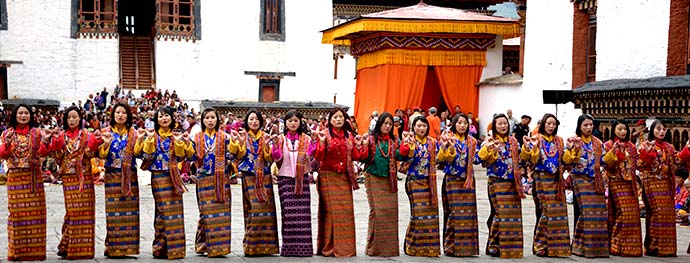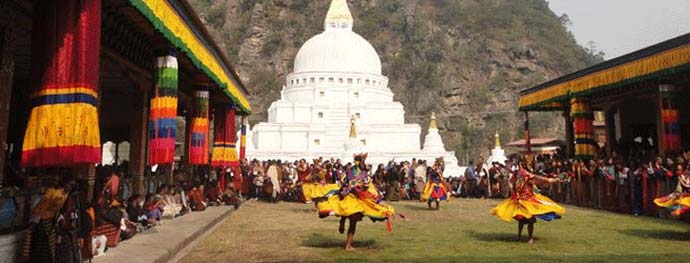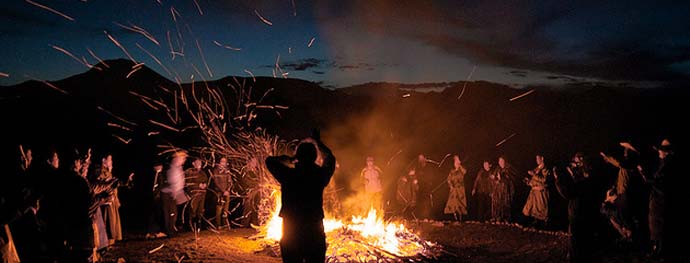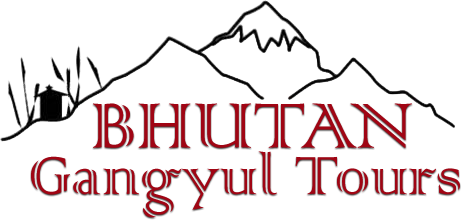- Air tickets to Bhutan (we can arrange to book your flights)
- Trip insurance
- Tips
- Alcoholic/soft drink beverages
- Travel insurance (This can be arranged with us)
- Luxury hotel upgrades (This can be done at an additional cost)
- Meals at 4-5 star restaurants
Tshechus and Domche - Festivals of Bhutan
Tshechu is a religious festival meaning "tenth day" held annually in various temples, monasteries and dzongs throughout the country.
Tshechus and Domche

Tshechu are annual religious Bhutanese festivals held in each district or dzongkhag of Bhutan on the tenth day of a month of the lunar Tibetan calendar. The month depends on the place. Tshechus are religious festivals of the Drukpa Lineage of the Kagyu school of Tibetan Buddhism.
Black-necked Crane Festival

The annual Black-Necked Crane festival is celebrated annually on 11th November at the courtyard of Gangtey Goenpa in Phobjikha valley, Wangduephodrang District. The Phobjikha valley is the largest winter habitat of Black-necked cranes in Bhutan with approximately 300 cranes every year.
The festival is an occasion for the locals to rejoice and celebrate the arrival of this endangered and majestic bird which becomes an inseparable part of their daily lives during the winter months. The annual event helps raise awareness on the endangered species, provide economic incentives for the locals and a means to renew the commitment of the communities to conserve the cranes. The festival includes cultural programs such as folk songs and mask dances performed by the local people, crane dances and environmental conservation-themed dramas and songs by school children.
Chorten Kora Festival

The Chorten Kora Festival is held in the easternmost district Trashiyangtse. The chorten (stupa) was built by Lama Ngawang Loday in 1740 to subdue a demon and it was dedicated to the memory of his late uncle Jungshu Pesan.
The story behind the chorten is that Lama Ngawang Loday went to Nepal and brought back a model of Boudhanath carved in a radish. He had it copied here so that people could visit this place instead of making the arduous trip to Nepal. The reason that Chorten Kora is not an exact copy of Boudhanath is because the radish shrank and became distorted during the return trip.
The festival is celebrated on two separate dates; Dakpa Kora for the Dakpa community of Arunachal Pradesh, India and Drukpa Kora for the Bhutanese people. Legend has it that a young girl from Tawang (Arunachal Pradesh) believe to have been a Dakini agreed to be buried alive inside the chorten to appease a troublesome demon. Thus hundreds of people of the Dakpa community take the pilgrimage to Chorten Kora to celebrate the sacrifice of the Daikini.
The Naked Dance of Jambay Lhakhang

A very unique and important festival that is held in central Bhutan (Bumthang) which has two main highlights; the “Mewang” and the “Tercham”.
Mewang is a fire ceremony/dance that is held in the evening to bless infertile women so that they may bear children. The Tercham is the naked dance where at the stroke of midnight; sixteen naked men sprint out of the monastery’s door dancing to the beatings of the traditional drums and cymbals. The dancers are completely naked except for their faces which are covered in white cloth and masks. Since the 16 dancers are actually people from the villages, families and friends are left guessing who could be behind those masks. Even if someone does recognize the performers, they are not allowed to call their names out in the crowd.
It is believed that the dance was introduced by the great treasure discoverer, Tertoen Dorji Lingpa in the 8th century. Stories claim that the demons were delaying the construction of a monastery by destroying it every night. Tertoen Dorji Lingpa introduced this sacred dance to distract the demons while the monastery was built and completed. During the consecration of the monastery the dance became part of the Monastery’s annual event.

